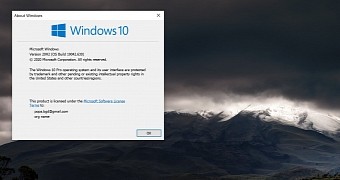Windows 10 version 20H2 is still on its way to some devices out there, as the rollout is obviously under way as we speak, though as we learned from the previous feature update releases, it typically takes up to several months for a specific version to reach the general availability stage.
But while this happens, Microsoft needs to deal with all the issues that users are coming across, and to do this, the company turns to so-called compatibility bugs for a feature update.
In other words, if Microsoft determines a specific issue could hit your device, the company blocks a Windows 10 version from being offered on Windows Update, thus making sure that fewer computers are actually impacted when a new glitch is discovered.
This is without a doubt the correct approach, and while it may be frustrating for some of those not getting an update, it’s one way to prevent major issues.
And these major issues could include a fatal crash too, as it’s the case of a Thunderbolt-related problem that was acknowledged by Microsoft earlier this month.
More specifically, the Redmond-based tech giant has discovered that some users who plug In a Thunderbolt NVMe SSD in their devices running Windows 10 version 2004 or 20H2 could end up getting a Blue Screen of Death error.
What happens next is obviously a forced reboot of the device, and plugging in the SSD again causes another fatal crash. And again and again, as the problem doesn’t go away if you’re running one of the two versions of Windows 10 that are affected by this glitch.
“An incompatibility issue has been found with Windows 10, version 2004 or Windows 10, version 20H2 when using an Thunderbolt NVMe Solid State Disk (SSD). On affected devices, when plugging in a Thunderbolt NVMe SSD you might receive a stop error with a blue screen and "DRIVER_VERIFIER_DMA_VIOLATION (e6) An illegal DMA operation was attempted by a driver being verified." Affected Windows 10 devices will have at least one Thunderbolt port and any currently available version of the driver file stornvme.sys,” Microsoft explains.
As I explained earlier, these are moments when Microsoft goes for compatibility holds, as it’s pretty clear such a problem can substantially affect your experience with Windows 10. So right now, if you have a Thunderbolt NVMe SSD that could be impacted by this issue and you attempt to update to one of the two OS versions mentioned above, you won’t be seeing the update on Windows Update.
“To safeguard your update experience, we have applied a compatibility hold on Windows 10 devices with affected drivers from being offered Windows 10, version 2004 or Windows 10, version 20H2. If your organization is using Update Compliance, the safeguard IDs is 29991611,” the company explains.
Of course, there are other ways you can install the latest version of Windows 10 such as the Media Creation Tool or standalone ISO image, but Microsoft recommends against doing it, as the likelihood of issues is obviously high.
“We are working on a resolution and estimate a solution will be available in late November. We recommend that you do not attempt to manually update using the Update now button or the Media Creation Tool until the safeguard is removed,” the company said.
It’s already late November and a workaround does not exist just yet, so the only option right now is to just wait for a few more days until a fix gets the go-ahead. There’s a chance it lands on the next Patch Tuesday, which according to Microsoft’s typical schedule, it is projected to kick off on December 8.

 14 DAY TRIAL //
14 DAY TRIAL //